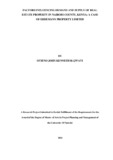Factors Influencing Demand and Supply of Real Estate Property in Nairobi County, Kenya: a Case Of Erdemann Property Limited
Abstract
Nowadays, rapid increase in population, immense migration of people to urban
centers and industrialization has forced the government and realtors to rethink on
ways to fulfill the increased demand for real estate properties especially in urban
areas. However, most governments have participated minimally in this sector leaving
the private sector to dominate the industry despite demand being high while supply is
low. In Kenya, investment in real estate has been a major sector that is attracting
many potential investors contributing to 12% of GDP. Real estate property market has
been booming in Kenya in the past decade and it continues to boom. However,
demand and supply for real properties continues to pose a great challenge in the
country particularly in urban towns due to urbanization. The high demand for housing
against a background of limited supply has resulted into deplorable shelter conditions.
The purpose of this study is to establish the influence of demand and supply of real
estate property in Nairobi County, Kenya, with focus to Erdemann Property Limited.
The study was guided by the following specific objectives, that is, to establish how
price, economic situation, land availability and demographic profile influences
demand and supply of real estate property in Nairobi County. This study employed
descriptive research design. The target population of this study was managers working
at Erdemann Property Limited in Nairobi County. Simple random sampling technique
was used to select 8 respondents. The study relied mostly on primary data sources
where self-administered questionnaire was utilized as source of data. Data collected
for this study was purely quantitative. Quantitative data was coded and entered into
Statistical Packages for Social Scientists (SPSS Version 17.0) and MS. Excel and
analyzed using descriptive statistics. The finding was presented in form of frequency
tables and explanation is presented in prose. The knowledge established from this
study is useful in helping the regulatory authorities and real estate developers to
formulate future policies aiming at meeting demand of the real estate property. The
study concluded that competition for limited key resources and sharp increases in the
price of some building materials has led to high costs of housing. High cost of land in
areas profiled as prime areas hinders real estate developers to meet the demand of
affordable housing in such areas. Property taxes, property insurance, mortgage fee and
insurance, regular maintenance and sporadic upgrades, higher utilities limit the
demand and supply of real estate property. Finally, the study concludes that increased
demand for real estate property in most urban areas leads to building more housing
developments and accelerated growth in supply of property in that area. The study
recommends that the government should regulate the real estate market and since
demand is expected to keep on increasing; persistent regulatory restrictions on land
supply or how intensively land can be used should be put in place. The government
should put in place measures to check house price inflation and rental inflation which
can deviate when supply of new housing is slow to respond to changes in market
conditions. The National and County governments should have master plans and zone
the city bearing in mind the needs for housing for its occupants. The county
government should amend the available planning laws in order to allow construction
of more buildings in the study area.
Publisher
University of Nairobi
Rights
Attribution-NonCommercial-NoDerivs 3.0 United StatesUsage Rights
http://creativecommons.org/licenses/by-nc-nd/3.0/us/Collections
- Faculty of Education (FEd) [6022]
The following license files are associated with this item:


